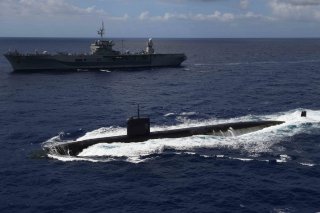U.S. Navy to Use Drones to Provide Eye in the Sky for Submarines
the U.S. Navy is now exploring ways that small unmanned aerial vehicles (UAVs) would increase what the crew of a submarine is able to see. The Navy has largely been focused on unmanned surface and underwater vehicles, but a small drone equipped with cameras could certainly offer a bigger picture of the operational situation for a submarine.
Traveling under the water provides concealment for submarines, but it also seriously limits the ability of the crew to know what is above them. Since the introduction of military submarines, the periscope has provided the only view of the surface and that has always been extremely limited.
According to Business Insider, the U.S. Navy is now exploring ways that small unmanned aerial vehicles (UAVs) would increase what the crew of a submarine is able to see. The Navy has largely been focused on unmanned surface and underwater vehicles, but a small drone equipped with cameras could certainly offer a bigger picture of the operational situation for a submarine.
"We are pursuing the use of unmanned aircraft launched form submarines," said Rear Adm. Black Converse, command of the U.S. Navy's Pacific Fleet Submarine Force at the Navy Submarine League's annual symposium last week. "We developed a common operating picture, actually, for over-the-horizon targeting for some of our anti-ship cruise-missile capabilities that we have now and we're going to be delivering to the forces in the future."
A submarine-deployed UAV would thus act essentially as a "flying periscope" and could dramatically extend the crew's organic sensor range, and provide target-quality sensor data back to the crew. It could also provide joint force capability and enable Harpoon and Maritime Strike Tomahawk missile engagements Converse added.
Remote Delivery
In addition to extending the ability of a submarine to see greater distances, the U.S. Navy has also launched a research program to address how small aerial drones could deliver cargo to submarines at sea. The Navy has been testing a prototype of the Blue Water Maritime Logistics UAS that was developed by the Austin-based Skyways. The tests have demonstrated the long-range naval ship-to-ship and ship-to-short cargo transports.
This likely won't replace the way cargo is currently delivered – which includes the use of boats and helicopters including the MH-60R Seahawk. While heavy equipment and larger cargo will still use traditional methods, a vast majority of the goods weigh less than 22.7 kilograms and this is where drones could complement other delivery efforts.
"This requirement is unlike other cargo requirements that online retailers like Amazon are exploring," said Blue Water's project lead, Bill Macchione, according to the news outlet Inceptive Mind, which reports on cutting edge technology. "Naval cargo transport requires vehicles that can successfully operate through difficult environments that include heavy winds, open water, and pitching vessels at sea."
The Blue Water logistics UAS is equipped with propellers, which allow for vertical takeoff and landing, and it can operate autonomously to carry cargo weighing up to 9.1 kilograms to a moving ship or submarine that is 21.7 nautical miles away.
The use of drones could both extend what submarines see and also how they receive delivery of important cargo. Of course, there are still issues of weather to address, but in the future, the crew of the submarine could have a better picture of what they face than just what the captain sees through a periscope.
Peter Suciu is a Michigan-based writer who has contributed to more than four dozen magazines, newspapers and websites. He is the author of several books on military headgear including A Gallery of Military Headdress, which is available on Amazon.com.

